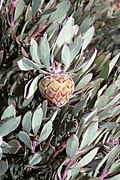Description
This plant grows as an erect shrub up to three metres tall. [6] The younger branches are softly hirsute, eventually becoming glabrous with age. [8] The leaves are glaucous, [5] distinctly veined beneath, 0.75–1.75 inches (1.9–4.4 cm) in length, and approximately 0.5 cm in width. They are shaped narrowly-oblanceolate, ending in an acute apex with a mucronate tip. Young leaves are covered in a very minute, loose pubescence, but become glabrous as they get older. [8]
The flowers are bourne on a specialised inflorescence, a flower head or pseudanthium. The flower head is sessile, 1.5 inches (3.8 cm) in length, and around 1.5 inches (3.8 cm) in diameter. [8] The flower heads are dropping, opening downwards. [5] [8] It is monoecious, with both sexes occurring in each flower. [6] The inflorescences are produced in the late autumn to winter, mostly in May to June, extending to August. [5] [6] There are seven to eight series of involucral bracts. [8] The outer bracts are often coloured a dull, mealy red, [5] are shaped ovate to subacuminate (somewhat pointy), with an obtuse apex, and covered in silky-pubescent or tomentose hairs on their lower halves. Their margins are membranous and ciliate (fringed with hairs). The inner bracts are longer than the actual flowers and are shaped obtuse, in-curved at their tops, slightly concave and covered in minute pubescent hairs on their outsides. The petals and sepals of the flowers are fused into a 19mm long perianth-sheath. This sheath is dilated, having three keels and three veins at its base, and reddish, pilose hairs on the outside of the very top of the sheath, where it has a 5mm long lip with the underside covered in a few, stiff, setose (bristly) hairs of a reddish colour. The lip is three-toothed, with each tooth almost equal in length, 0.7mm. All of the stamens are fertile. The anthers are linear and 2.6mm long. The apical glands are ovate and somewhat less than 0.3mm in length. The ovary is oblong and covered in long, reddish-brown hairs. The style is glabrous, compressed, curved to falcate in shape and some 21.2mm long. It is obliquely dilated above the ovary, then gradually tapering. The stigma is 3.2mm long, thread-like in shape, obtuse, and almost imperceptibly becomes the style. [8]
Similar species
It is similar to Protea effusa , as well as P. sulphurea, from which it differs by having narrower leaves with more distinct venation. It is also somewhat similar to P. witzenbergiana, differing from that species in having long, foliaceous, leaf-like, outer involucral bracts. [8] : 594 [9]
Ecology
The adult plants are killed by wildfires, but the seeds can survive such an event. The flowers are pollinated by birds. The fruits are numerous, studding the base of the dried, old flower head, which itself remains attached to the plant after senescence. The seeds are retained in the fruits for a few years, until they are eventually dispersed by the wind. [6]
Habitat
It exclusively grows in a fynbos habitat, [4] in a range of between 1,000 and 2,000 metres in altitude. Within such lands it grows in arid, rocky areas, and on krantzes (crags or cliffs). [6]
This page is based on this
Wikipedia article Text is available under the
CC BY-SA 4.0 license; additional terms may apply.
Images, videos and audio are available under their respective licenses.













